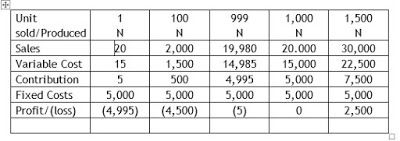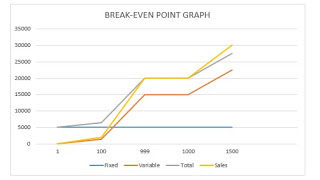Business Plans And Feasibility Studies
Table of Contents
In fact, Break-Even Point (BEP) for an organisation is a point at which there is no profit and no loss in the business activities. It is a point in the financial analysis where the organisation covers its total cost but makes no profit. At this point total cost equals fixed cost plus variable cost i.e. Total Cost = Fixed cost + Variable costs. A company has achieved break-even when its total sales or revenues equal its total expenses ( Total Cost = Total Revenue = zero profit). No profit has been made at the break-even point, nor have any losses been incurred. As a matter of fact,this calculation is critical for any business owner because the break-even point is the lower limit of profit when determining margins.
READ ALSO: Writing Your Business Plan – Get Started.
Generally speaking, it is derived narratively, mathematically and graphically.
Some of the questions to answer in this article are:
importance of break even point analysis in business planning
role of break even analysis in profit planning
importance of break even analysis in business decisions
ASSUMPTIONS FOR BREAK EVEN ANALYSIS
Break-Even-Point(BEP) Analysis For Business Plans And Feasibility Studies
COST BEHAVIOUR
Break-Even-Point(BEP) Analysis For Business Plans And Feasibility Studies
EXPLANATION OF COST VARIABLES/ELEMENTS
Fixed costs:
Variable costs:
What is CONTRIBUTION, and what is its relationship with PROFIT?
I will explain this by the following common sense reasoning equations:
Sales – Total Cost = Profit ………………………….. (i)
Total cost = Fixed cost + Variable costs……………. (ii)
Substitute equation (ii) into equation…………. (i)
Sales – Fixed cost + Variable cost) = Profit……….. (iii)
(Sales – Variable cost) – Fixed cost = Profit……….. (iv)
Sales – Variable cost = Contribution……………………. (v)
Substitute equation (V) into equation (iv)
Contribution – Fixed cost = Profit …………………… (Vi)
Contribution = Fixed cost + Profit ……………………… (vii)
Contribution which is Sales less Variable costs is what is left from turnover after recovering all the direct or variable cost. It is contribution towards off-setting the fixed cost. A business man can still remain in business at this point. But he must work hard to generate enough contributions from his various activities to off-set the fixed cost when they are due for renewal again, otherwise the business folds.
Let me illustrate further with the following table.
 |
| BEP Table |
Break-Even-Point(BEP) Analysis For Business Plans And Feasibility Studies
Correspondingly, notice that one particular feature which fixed cost exhibits is that it is always constant no matter the quantity involved. Note also that variable cost varies according to quantity sold. Therefore in determining the break-even point of your business, factors to manipulate are quantity, price and expenses. In the table above the organisation can not sell quantity below 1,000 units.
The Break-even Formula: How to Do a Break-even Analysis
This is fairly simple. To conduct your break-even analysis, take your fixed costs divided by your price minus your variable costs. As an equation, this is defined as:
Break-even Point = Fixed Costs/(Unit Selling Price – Variable Costs). Using figures from our table this is:
This calculation will clearly show you how many units of a product you must sell in order to break even. You’ve recovered all costs associated with producing your product, both variable and fixed, when you’ve reached this point.
Every additional unit sold after this increases profit by the amount of the unit contribution margin, which is defined as the amount each unit contributes to covering fixed costs nd increasing profits.
Break-Even-Point(BEP) Analysis For Business Plans And Feasibility Studies
Note that sales line intersects total cost at 1000 units.
PRICE SETTING
Setting a Price That Helps Your Business Hit Break-even:
Setting the right price is critical to your break-even analysis and eventually turning a profit with your start-up. You can’t calculate expected revenue if you don’t know what your unit price will be. Unit price is the amount you plan to charge customers to buy a single unit of your product.
Pricing can involve a complicated decision-making process on the part of the consumer, and plenty of research has gone into the marketing and psychology of how consumers perceive price. Take a little time to review articles on pricing strategy and the psychology of pricing before choosing how to price your product or service.
Break-Even-Point(BEP) Analysis For Business Plans And Feasibility Studies
Pricing methods:
There are several schools of thought on how to treat price when you’re conducting a break-even analysis. It’s a mix of quantitative and qualitative factors. You should be able to charge a premium price if you’ve created a brand new, unique product, but you’ll have to keep the price in line with the going rate or perhaps even offer a discount to get customers to switch to your company if you’re entering a competitive industry.
Cost-based pricing:
Price-based costing: This encourages business owners to “start with the price that consumers are willing to pay when they have competitive alternatives, and whittle down your costs to meet that price. This allows you to lower your price and still turn a profit if you encounter new competition. Different pricing methods can be used.
Limitations of the Break-even Analysis:
It’s important to understand what the results of your break-even analysis are telling you. If the calculation reports that you’ll break even when you sell 1000 units, your next step is to decide whether this seems feasible. You can also adjust your break-even quantity higher than the 1000 units to say 1,200 units, so that even if you don’t get the 1,200 units, you could eventually hit the 1000 minimum units. That extra is what is called ‘ Margin of safety’.
Break-Even-Point(BEP) Analysis For Business Plans And Feasibility Studies
If you don’t think you can sell 1000 units within a reasonable period of time as dictated by your financial situation, patience, and personal expectations, then this may not be the right business for you—it may not turn a profit quickly enough to stay alive. If you think 1000 units is possible but would take a bit of time, try lowering your price and calculating a new break-even point. You might also take a look at your costs, both fixed and variable, to identify areas where you might be able to make some cuts.
Again, understand that a break-even analysis is not a predictor of demand. If you go to market with the wrong product or the wrong price, it may be tough to ever hit the break-even point.
Realise also that these are all estimations, you have to work hard to achieve it. The division between variable and fixed costs may not be accurate. Environmental factors may not be built inside costs analysis yet. Click here for a sample BPlan
Contact us:
Contact us for Break-Even-Point(BEP) Analysis For Business Plans And Feasibility Studies. As a matter of fact, in Completefmc.com we structure a bankable business plan for small business startups. For every lean start up plan we develop, we add startup accelerator strategies. These we build into the business startup ideas generated by us. Therefore with Completefmc.com starting up a business is an experience. Added also are startup funds for lean start up and franchise opportunities. Contact us on +234 8034347851 or cfmclimited@gmail.com to get in touch with us
If you have enjoyed this article please say so by making comments through the comment platform. That will help me serve you better. Click any of the social media button at the top of this page to like us or follow us. Ensure you keep in touch with us. If you have business challenges contact us.

Deacon Anekperechi Nworgu, a seasoned economist who transitioned into a chartered accountant, auditor, tax practitioner, and business consultant, brings with him a wealth of industry expertise spanning over 37 years.




